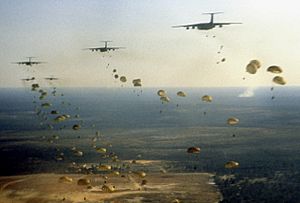Operation Golden Pheasant facts for kids
Quick facts for kids Operation Golden Pheasant |
|||||||
|---|---|---|---|---|---|---|---|
|
|||||||
| Belligerents | |||||||
| Commanders and leaders | |||||||
| Units involved | |||||||
| Strength | |||||||
| Casualties and losses | |||||||
Operation Golden Pheasant was a quick mission by the U.S. military in 1988. It involved sending troops to Honduras to stop attacks from Nicaragua. These attacks were aimed at supply bases used by a rebel group called the Contras.
Contents
Operation Golden Pheasant
What Happened?
In March 1988, Nicaragua's government, led by the Sandinistas, started a military action. They called it Operation Danto. Their goal was to capture supply areas used by the Contra rebels. To do this, Nicaraguan forces crossed into Honduran territory.
The US Response

The United States, under President Ronald Reagan, quickly sent soldiers to Honduras. These were from the 7th Infantry Division. They landed at Palmerola Air Base. They then moved to a Honduran military base. Their job was to protect a local general.
Other special forces and aviation units were already there. They worked with the 7th Infantry Division. Soon, more soldiers from the 82nd Airborne Division arrived. This quick show of force made the Nicaraguan Sandinista troops leave Honduras.
Soldiers Arrive
More US soldiers joined the mission. These included troops from the 504th and 505th Parachute Infantry Regiments. They were part of the 82nd Airborne Division. Soldiers from the 9th and 27th Infantry Regiments also arrived. These units were from the 7th Infantry Division.
On March 17, 1988, the 1st Battalion landed at Palmerola Air Base. The 2nd Battalion parachuted onto the airfield the same day. Soldiers from the 27th Infantry Regiment also arrived. They were quickly moved close to the Nicaraguan border.
US soldiers trained with Honduran army units. For example, the 2nd Battalion of the 27th Infantry trained with the Honduran 11th Infantry Battalion. This helped both armies work together.
Before the Main Deployment
Before the combat troops arrived, US engineers were already in Honduras. About 1,100 engineers were there for an exercise called Ahuas Tara 88. They were building roads, bridges, and other structures. This exercise helped build trust with allied forces. These engineers also supported the arriving combat troops. They provided help with building, supplies, and communications.
Quick Withdrawal
The US soldiers began training exercises. They were told to stay away from the fighting at the border. However, they were ready to fight if needed. But the Nicaraguan Sandinista troops had already started to leave.
Within a few days, the Nicaraguan government agreed to a truce. This was a peace agreement with the Contra leaders. By the end of March, the US troops returned home. The 7th Infantry Division went back to Fort Ord, California. The 82nd Airborne Division returned to Fort Bragg.
See also
 In Spanish: Operación Faisán Dorado para niños
In Spanish: Operación Faisán Dorado para niños

